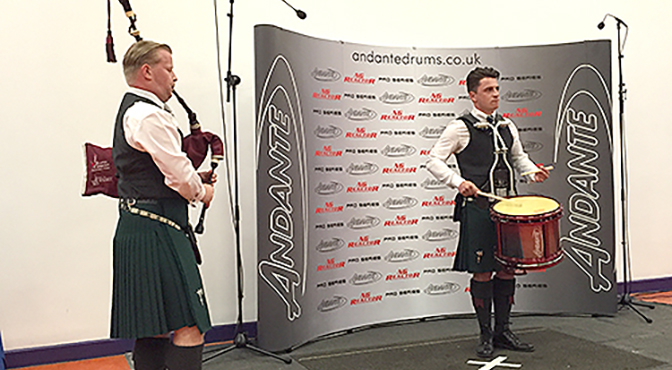
Some say he is as thick skinned as the first Andante….others that he knew the original Pretty Marion, even more that he doesn’t know one end of a KP2 from the other. All we know is he’s called MacStig……
As the viewing statistics of the World Solo Drumming performances clock up on YouTube, the top Juvenile Section (Juvenile 5 Snare – March, Strathspey & Reel) videos are also gathering momentum. The Twitter clips in real time as each competitor started were excellent for the very demographic of the competitors and their networks.With the Juvenile 5 performances going online quickly, the viral distribution continued. Fair play to the RSPBA Social Media Team for seeing the necessity of this sort of digital and online coverage for this demographic. Each competitor acts like a mini distributor to their own network, and off it goes. This is a dynamic any organisation has to embrace to stay relevant nowadays.
For those who didn’t follow the competition, there were 10 Juvenile categories (five each in Snare and Tenor). Almost 50 Tenor and approaching 100 Snare drummers playing from 9am until almost 6pm. But when is Juvenile not Juvenile?
In last week’s preview piece, I alluded to the number of Grade 1 bands represented in the Juvenile 5 competition. The point being that by the time players reach this Section it really has ceased to be ‘Juvenile’. In Section 5, the Grade 1 band names were there to see, and even trickled into Sections 4 and 3. It’s a wider debate for a different time perhaps, but has Juvenile become a thing of the past? Beyond the Novice Grade, is age relevant?

The 2017 solo competition rules state that the age of the competitor as of 1st November 2016 is the anchor point. In practical terms that means anyone who became 18 after November 1st 2016 could still enter ‘Juvenile 5’ in 2017. In that upper category those ‘older’ players have generally left school and been picked up by Grade 1 bands.
Two competitors had obviously been so since entering, as the kilts gave away their elevations to Grade 1. And those promotions are not unwarranted as the quality of playing is there for all to see via those online videos. The standard was extremely high and the fast hands some of these young adults demonstrated were exceptional. The results are here. Glasgow Police, FMM, Boghall and Johnstone all in the top six.
[wds id=”6″]
In the World Juvenile Tenor Solo competition, elsewhere on the campus, around 50 drummers (each with a piper and snare in tow) started at 1.45pm, reaching to top of the grade to finish just after 6pm. In Tenor 5 the same pattern, with Grade 1 names present, although the winner came from Quinn Memorial.
Looking at all the summary and scores online, there are often some wide spreads between adjudicator scores, perhaps underscoring vehement judge independence, but one of the most frustrating things a competitor will face. I don’t have a clever answer and the debate will rage forever, until a methodology like ice skating or high diving scoring comes in. It shows the world that this is a very subjective and opinion driven competition. As an aside, the Adult champion managed to take a full house of 1st places from the panel of four judges in the Hornpipe & Jig though. The March Strathspey & Reel scores were more mixed across the board.
I was thinking post event, where do you compete if you are a drummer in a Grade 2 or lower band? There is no real avenue and none progressed beyond the heats. So after Juvenile, then what? The step to the Adult contest, and progressing to the semi final is huge. Of recent Juvenile 5 winners, Grant Cassidy (SLoT) is the main success and a fixture in the final these past few years. The extremely talented Wenlock brothers (Vale) have knocked on the door, with Marcus in the final at the first attempt post Juvenile two years ago. Time will tell if graduating ‘juveniles’ simply have to accept some fallow years first.

It is worth noting that at the very highest level, this is not a hobby for some. In the Adult contest those floating to the top are often professional musicians, drummers, percussionists, and teachers. They have sticks in their hand for hours every day. The hobbyists have no real chance.
Maybe it is time to consider looking at the model in North America with a Professional or ‘Open’ grade and then sticking to gradings thereafter. Just as juvenile bands should perhaps be absorbed into the other grades (recognising the adult P/M allowance would fall). The old adage suggests ‘If you are good enough you are old enough’. In closing this line of thought, and anecdotally, I watched a very talented young drummer in Juvenile 3 MSR. He plays in a grade 1 back line in Canada and competes at home in grade 1 contests (just below Professional). He won. Deservedly. In that category too were newly promoted Juvenile, former Novice Juvenile A, players. No contest. As the Nobel Laureate uttered, ‘the times they are a’changin’.
It was a great day of competition, wizardly logistics and slick organisation, albeit a long day for all. Some air conditioning in the main arena would be welcomed too. It was also interesting to read the qualifiers flashing by on Twitter and old school white board being written up too (in case of power cuts and network failure of course). If you didn’t get your car park ticket endorsed at the University do it next time, save a fortune on parking.
Full respect to People’s Ford Boghall & Bathgate Caledonia with a significant 25 drummers across the competitions. That is a great effort from Mr Brown & Co (pictured top). Well done to all concerned. Five star contest. Over and out.
[wds id=”3″]
















Recent Comments